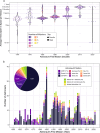Astronaut omics and the impact of space on the human body at scale
- PMID: 38862505
- PMCID: PMC11166943
- DOI: 10.1038/s41467-024-47237-0
Astronaut omics and the impact of space on the human body at scale
Abstract
Future multi-year crewed planetary missions will motivate advances in aerospace nutrition and telehealth. On Earth, the Human Cell Atlas project aims to spatially map all cell types in the human body. Here, we propose that a parallel Human Cell Space Atlas could serve as an openly available, global resource for space life science research. As humanity becomes increasingly spacefaring, high-resolution omics on orbit could permit an advent of precision spaceflight healthcare. Alongside the scientific potential, we consider the complex ethical, cultural, and legal challenges intrinsic to the human space omics discipline, and how philosophical frameworks may benefit from international perspectives.
© 2024. The Author(s).
Conflict of interest statement
D.B. is Co-founder of Poppy Health, Inc. and CSO of Yuri Gravity GmbH; C.E.M is Co-Founder of Onegevity Health; S.G. is scientific advisor to 10x Genomics, which holds IP right to the ST technology, and holds stocks. The remaining authors declare no competing interests.
Figures



Similar articles
-
The Space Omics and Medical Atlas (SOMA) and international astronaut biobank.Nature. 2024 Aug;632(8027):1145-1154. doi: 10.1038/s41586-024-07639-y. Epub 2024 Jun 11. Nature. 2024. PMID: 38862028 Free PMC article.
-
Health care for deep space explorers.Ann ICRP. 2020 Dec;49(1_suppl):182-184. doi: 10.1177/0146645320935288. Epub 2020 Jul 31. Ann ICRP. 2020. PMID: 32734760
-
Fundamental Biological Features of Spaceflight: Advancing the Field to Enable Deep-Space Exploration.Cell. 2020 Nov 25;183(5):1162-1184. doi: 10.1016/j.cell.2020.10.050. Cell. 2020. PMID: 33242416 Free PMC article. Review.
-
Toward Next-Generation Phenomics: Precision Medicine, Spaceflight, Astronaut Omics, and Beyond.OMICS. 2024 Aug;28(8):377-379. doi: 10.1089/omi.2024.0164. Epub 2024 Jul 17. OMICS. 2024. PMID: 39017624
-
On-orbit sleep problems of astronauts and countermeasures.Mil Med Res. 2018 May 30;5(1):17. doi: 10.1186/s40779-018-0165-6. Mil Med Res. 2018. PMID: 29843821 Free PMC article. Review.
Cited by
-
A second space age spanning omics, platforms and medicine across orbits.Nature. 2024 Aug;632(8027):995-1008. doi: 10.1038/s41586-024-07586-8. Epub 2024 Jun 11. Nature. 2024. PMID: 38862027 Free PMC article. Review.
-
Evolutionary medicine and bioastronautics: an innovative approach in addressing adverse mental health effects to astronauts during long term space missions.Front Physiol. 2025 Apr 24;16:1558625. doi: 10.3389/fphys.2025.1558625. eCollection 2025. Front Physiol. 2025. PMID: 40342860 Free PMC article.
-
Direct RNA sequencing of astronaut blood reveals spaceflight-associated m6A increases and hematopoietic transcriptional responses.Nat Commun. 2024 Jun 11;15(1):4950. doi: 10.1038/s41467-024-48929-3. Nat Commun. 2024. PMID: 38862496 Free PMC article.
-
Protective alleles and precision healthcare in crewed spaceflight.Nat Commun. 2024 Jul 22;15(1):6158. doi: 10.1038/s41467-024-49423-6. Nat Commun. 2024. PMID: 39039045 Free PMC article. Review.
-
Genome and clonal hematopoiesis stability contrasts with immune, cfDNA, mitochondrial, and telomere length changes during short duration spaceflight.Precis Clin Med. 2024 Apr 8;7(1):pbae007. doi: 10.1093/pcmedi/pbae007. eCollection 2024 Mar. Precis Clin Med. 2024. PMID: 38634106 Free PMC article.
References
-
- Mason, C. E. TheNext 500 Years: Engineering Life to Reach New Worlds. (MIT Press, 2021).
-
- Da Silveira W. A. et al. Revamping Space-omics in Europe. Cell Syst. 11, 555–556 (2020). - PubMed
Publication types
MeSH terms
Grants and funding
LinkOut - more resources
Full Text Sources
Research Materials

